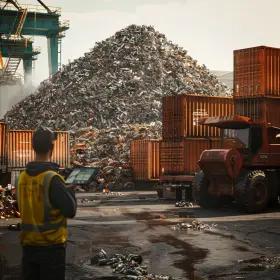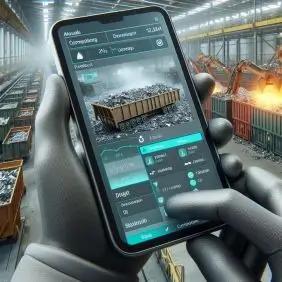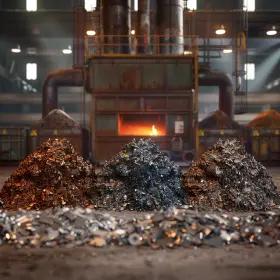Using AI and data to transform undefined scrap metal into specified and ‘smelter ready’ secondary metals: METYCLE makes metal recycling smart and transparent
The basics about secondary metal recycling and trade
Secondary metals are collected and processed at collection yards anywhere around the globe. Recycling ratios for metals in most countries reached very high levels over the past decades. Scrap metal or secondary metal is a precious resource to be used at smelters to close the loop and to repurpose secondary metal into industrial and consumer products. This process is highly CO2 effective compared to the primary production of metals, saving up to 95% CO2 emissions. However, large parts of the metal collected is traded inefficiently and in highly complex routes to get further sorted and its quality getting specified. So one of the main challenges to increase efficiency in metal recycling is to sort and to transparently specify the quality and composition of secondary metal. Another inefficiency is that the processing and the related CO2 savings along the value chain cannot be tracked in today’s analogue and multi-level trading processes.

Inefficiencies due to lack of product specification and product quality checks
Most secondary metal today is specified by visual and in person inspection on the yards and sold as such based on photo or video documentation. Very rarely equipment is used to specify the product quality and if so, the results of such analysis is kept with the supplier and not shared along the value chain. ISRI specification helps to classify the rough composition of material, but none of the materials sold is the ever the same. Even within one load of secondary metals one may find variations in product mix, purity, moisture levels and impurities. This in the supply chain leads to conservatism in pricing, assuming lowest levels of product quality and frequent product quality claims.
There is significant potential to address such inefficiencies by the introduction of smart sorting and quality check hubs. Such hubs will screen the incoming material for composition and quality.
The material can be shipped as is to buyers, but will be accompanied by a digital product pass showing the material composition and allow for the material to be tracked from source to smelter.


This allows to track the material flow and processing in real-time and to track the CO2 savings created from source to smelter. Also, this removes uncertainty on product quality, allowing to pricing of material to be accurate and efficient. Also, this removed the need to time consuming and costly claims.

Producing ‘smelter ready’ secondary metal
Alternatively, smart sorting equipment in recycling facilities uses advanced technologies such as Artificial Intelligence (AI), machine learning, and robotics to sort and separate various types of metal scrap. This equipment is capable of accurate and fast sorting, which drastically improves the recycling process's efficiency. It uses sensors and complex algorithms to differentiate between various metals, allowing for a higher quality and purity of the sorted metal scrap. It is not only efficient but also reduces the need for manual labor, resulting in safer and more cost-effective operations. The outcome of this process can be ‘smelter ready’ material, digitally certified and trackable from source to smelter.
In conclusion, the use of smart sorting equipment in metal recycling is a transformative approach that combines technological advancement with environmental responsibility. Its contributions to efficient waste management, the production of high-quality recycled metals, and improved safety standards are significant. As we look towards a sustainable and efficient future, the role of such advanced technologies in recycling and waste management will only become more critical.
At METYCLE we are at the first company to develop data models, algorithms and AI specific for secondary metal recycling. METYCLE allows for the usage of smart sorting hubs and equipment at scale. METYCLE is digitally transforming secondary metal recycling.
Read more
Recycle metals with us
Recycle metals with us
Our metals
- Aluminum: the economic impact of recycling
- Copper: uncovering the sustainable scrap cycle
- Lead: the journey of scrap metal recycling towards a greener future
- Magnesium: scrap as a renewable resource for circular economy
- Nickel: scrap recycling as a value maximizer for sustainable industry growth
- Zinc: the sustainable promise of scrap recycling
Inside METYCLE
Inside METYCLE
Engineering and Technology at Metycle
Want to stay updated via WhatsApp?
Stay ahead with METYCLE's products! Join our WhatsApp broadcast channel to receive real-time updates on available metals and unbeatable deals. Explore our current product offerings and never miss out on the best opportunities!
© 2025 METYCLE
